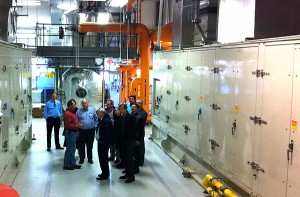Department of Energy meeting showcases NC State’s Cates Utility Plant


The campus utility plant where NC State generates up to 30 percent of its own electricity recently hosted a U.S. Department of Energy meeting that showcased the facility’s energy-saving technology.
The semi-annual director’s meeting of the Department of Energy’s (DOE) Regional Combined Heat and Power Technical Assistance Partnership (CHP TAP) met Dec. 3-4 at NC State’s Cates Utility Plant. The 11-megawatt facility features combined heat and power technology (CHP) that is projected to save the university $4.5 million annually and has been considered a model for successful CHP facilities across the country.
“The Cates Plant is a great facility to explore because we are going on two years of successful operation. During that time, we’ve learned a lot about managing a CHP facility, and are able to share with others some best practices, as well as things we would do differently and ways we are continuing to improve the plant,” said Isaac Panzarella, Director of the Southeast CHP TAP and Clean Power & Industrial Efficiency Project Coordinator at the university’s NC Clean Energy Technology Center.
Formed by DOE last year, the seven regional CHP TAPs, which promote implementation of energy-saving technologies such as district energy and converting waste heat to power, provide key services to companies and institutions including: market opportunity analyses, education and outreach, and technical assistance to end-users. NC State serves as the site for the 10-state Southeast CHP TAP project.
In addition to touring the Cates plant, the meeting’s 21 attendees – two from each of the CHP TAPs, as well as other DOE representatives –discussed continued national market transformation for CHP, microgrids and district energy with CHP.
CHP facilities use an engine or turbine to simultaneously generate electricity and useful heat. Before the renovation of the Cates Utility Plant in 2012, electrical power had been supplied to campus from the local power company. The installation of the CHP system marked the first time NC State had undertaken large-scale electricity generation.
“The controls and automation, as well as the cleanliness of the Cates Plant itself, were remarkable,” said Claudia Tighe, DOE’s CHP Deployment Program Manager. “The meeting was held at NC State this year to celebrate the remarkable year that the Southeast CHP TAP has had with significant CHP interest raised in Federal facilities, an effort that the Southeast CHP TAP leads. This significant work in transforming the CHP market was illustrated [by] Southeast CHP TAP’s director, Isaac Panzarella, receiving the coveted ‘CHP Champion of the Year’ award from the Combined Heat and Power Association.”
The Cates Utility Plant, located on NC State’s central campus, provides roughly 30 percent of the electrical power needs of main, central and north campus.
Learn more about how NC State’s Cates Utility Plant operates >>>